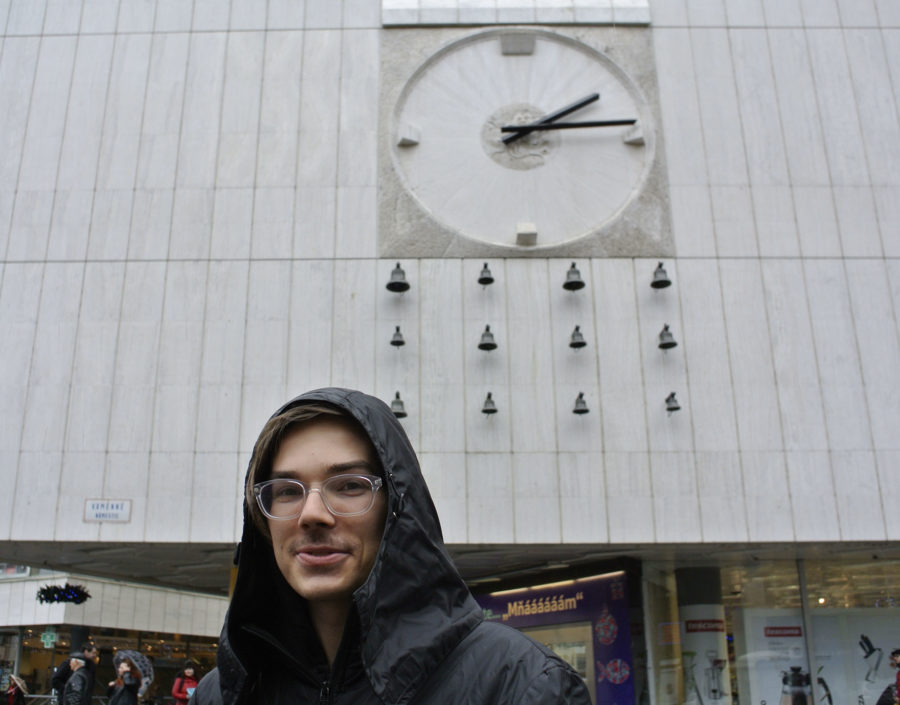Jonáš Gruska studied at the Institute of Sonology in The Hague and the Academy of Music in Kraków. He focuses on chaotic rhythms, explorations of the psychoacoustic properties of sound, and field recording. He has created several site-specific sound installations based on resonant properties of spaces and materials, and has given workshops on sonification, field recording, printed circuit board design, and programming for artists. He creates his own instruments and runs the label LOM in Bratislava.
You studied at the Institute of Sonology in The Hague. Where does your interest in the sonic come from? Were you always more interested in sound as such, than in music?
As a kid I studied classical guitar for a couple of years, played in a hardcore/punk band, and always found myself searching for the extremes. I travelled a lot, musically. In the end I found a comfortable place where I am now – approaching music and sound from different perspectives, free of preconceived notions.
How did your studies influence your perception of and work with sound?
They generally allowed me to grow as an artist and helped me realise what I really want to do with my life. Interacting with others and learning about different approaches was always beneficial and mind-expanding to me. I learned to trust my own ideas. Of course, I found out a lot about the technicalities of the work as well. It was an irreplaceable and strongly defining period of my life.
How would you describe your approach to sound?
At the moment, I am interested in sound as a whole. I love the physics of sound, psychoacoustics, acoustics, and field recording, but also composition, harmony, and melody, especially harmonies and tunings of traditional music from different parts of the world. Regarding my own work, I mostly work with sounds that have a specific spectral quality and interesting resonances, rich textures, and unconventional/chaotic rhythms.
After finishing your studies, you decided to return to your home country, Slovakia, and established the label, LOM. Can you talk about the imprint?
The idea of the label actually came about during my studies. I found myself disconnected from Slovak artists and realised how unknown they are to the world. So I wanted to create a platform that would help “export” and present them. I asked a couple of friends for help. We’ve built a website, started to collect contacts, and sent out records to the world. Over time, the concept changed a bit – we currently publish not only Slovak artists, but also Eastern-European experimental music and field recordings.
Aside from the various aspects of working with sound (recording, producing, engineering), you also started to create your own musical instruments and microphones. What led you to this, and could you describe the whole process behind the making of one (physical) instrument?
All of my instruments started as something that I needed for my work in field recording or as a performer. The ready-made instruments were either too expensive or not suitable for the job, so there was basically no other option than DIY. It started very simply when I was around 22 years old – I didn’t have an internet connection in my flat, which helped my online-addiction a lot and allowed me to focus on other things like lock-picking and electronics. I became fascinated with the world of DIY synthesizers and built dozens of different ones… I learned a lot back then about how it all works. Since I didn’t have a proper education in electronics, all of my work was more empirical and based on trial and error.
Now I am bit more advanced – I design products with proper circuit boards, assembled by robots, and with nice casing. But I maintain the DIY nature of things. For example I prepared a tutorial on the making of DIY Elektrosluch (my electromagnetic listening device) for Make magazine.
You are also interested in field recording, an area that has captured the imagination of many musicians and artists. How do you approach field recording and what environmental sounds do you look for in particular?
I don’t have any particular favourite environments for my field recording work. I recorded the depths of an old concrete bridge as well as the pure sounds of meadows around Slovakia last summer. I simply enjoy different sounds; there are very little boundaries.
In general, I like to do field recording with unusual microphone techniques (untraditional mic. placement), or unusual microphones – hydrophones, contact, or electromagnetic mics. Recently I’ve also been experimenting with ultrasonic bat detectors in my work, which is very inspiring.
